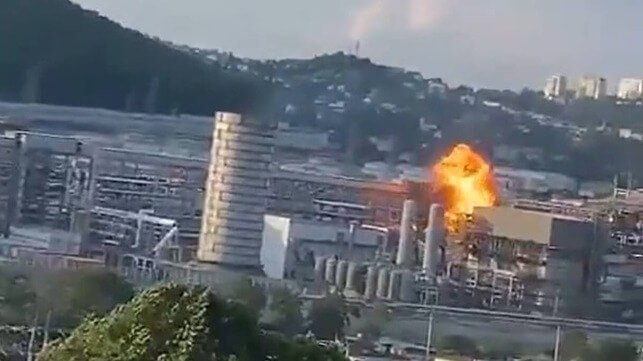Israel tries to discredit Palestinian journalists with unsubstantiated ‘terrorist’ labels. Jodie Ginsberg says Israel must end attacks on the media.
Jodie Ginsberg
18 Nov, 2024

Al Jazeera's Gaza bureau chief Wael Dahdouh mourning his son, journalist Hamza Dahdouh who was killed alongside freelance video journalist Mustafa Thuraya in an Israeli drone strike in Rafah. [GETTY]
Moments before he was killed in 2004, student journalist and freelance photographer Mohamed Abu Halima spoke on the phone to a producer at his radio station, describing the army jeeps he had seen close to Balata refugee camp, outside the city of Nablus in the West Bank. The producer, Moaz Shraida, said Abu Halima told him he had started to photograph the jeeps. Shraida heard gunfire. Then, nothing.
According to witnesses, Abu Halima was shot in the stomach by Israeli armed forces (Palestinian journalists describe the waist and neck as the spots favoured by the Israel Defence Forces (IDF) because they are not covered by body armour). He died in hospital. A spokesperson for the IDF at the time said that as far as the army knew, Abu Halima “was not a journalist" and that he "was armed and he opened fire on IDF forces". To the Committee to Protect Journalists’ (CPJ) knowledge, no investigation has ever been held into the journalist’s killing.
Twenty years later, this pattern in which Israel alleges that journalists are militants or terrorists – without providing credible evidence or undertaking transparent investigations into their killings – persists.
Related
The stain on Western media press vests is from the blood of Gaza
Voices
Myriam Francois
Israel’s tactics
Smearing journalists as criminals is a tactic particularly prevalent in autocratic regimes – but also a tactic used frequently by Israel in recent decades – and has two clear aims. The first is to justify attacks on journalists after the fact. A CPJ report published in May 2023 found that in at least six of the 20 cases of journalists killed by the IDF over the preceding 22 years, the IDF had alleged the individuals were involved in militant activity. In none of the 20 cases has anyone been held accountable for the deaths and few have even been accorded a transparent investigation.
The second tactic is intended to discredit Palestinian journalists more broadly. By seeding the idea that the journalists – the only individuals able to report what is happening inside Gaza – are terrorists, Israel can effectively smear all Palestinian journalists. This aims to undermine their credibility and thus, by extension, asks viewers and readers to doubt what they are seeing, and therefore to dismiss it.
It seems no coincidence that the allegations against the six Al Jazeera journalists in October came just as the IDF launched a major violent offensive that one senior officer said was aimed at creating a “cleansed space” in northern Gaza. Palestinian journalists who have been trying to report from the area told CPJ that atrocities were being committed amid a “news void”.
Related
Rafah bloodbath: Now we know why Israel banned Al Jazeera
Voices
Farrah Koutteineh
Last month, Israel published documents it said proved six Al Jazeera journalists operating in Gaza were affiliated with militant groups. Al Jazeera vehemently rejected the claims, which came as Israel launched an assault on northern Gaza, attacks that rights groups said amounted to ethnic cleansing. Al Jazeera is one of the few major international broadcasters to still have reporters providing daily broadcasts from Gaza, where no international journalists have been allowed independent access since the start of the war.
Unreliable justifications
CPJ has been unable to independently verify the documents shared by the IDF on social media, but other experts have cast doubt on these and other similar documents produced in the past. For example, following the killing of Al Jazeera correspondent Ismail Al Ghoul and freelance camera operator Rami Al Refee in a drone strike in July, the IDF published documents that showed Al Ghoul, born in 1997, received a Hamas military ranking in 2007. He would have been 10 years old.
After Al Jazeera journalist Hamza Al Dahdouh and freelancer Mustafa Thuraya were killed in an Israeli strike on January 7, Israel alleged that they were terrorists operating a drone “posing a threat” to IDF soldiers. A Washington Post analysis of their drone footage found “no indications that either man was operating as anything other than a journalist that day.” The available footage shows that the journalists did not film any IDF troops, aircraft, or military equipment, nor were there any indications of IDF troops in the vicinity of the area they filmed.
The Washington Post investigation also noted that both journalists passed through Israeli checkpoints on their way to the south early in the war and that Dahdouh had been approved to leave Gaza—“a rare privilege unlikely to have been granted to a known militant.”
Related
By banning UNRWA, Israel attempts to erase Palestinian refugees
Perspectives
Lex Takkenberg
The smear tactics are all part of a deliberate and much broader campaign to censor information coming out of Gaza and the West Bank that includes the targeting and killing of journalists, attacks on media facilities, bans on foreign media mainly targeted at Al Jazeera’s reporting, and threats to independent news outlets like Haaretz.
And it is having its desired effect: to disguise and diminish in the public’s eyes the catastrophic and disproportionate impact of the war on Palestinian civilians, and to dehumanise those suffering to help justify Israel’s disproportionate assault on Gaza.
This must not be allowed to stand. CPJ has called repeatedly for Israel to halt its attacks on the media and for Israel’s allies to use all tools at their disposal to ensure Israel upholds its commitments to a free press: this includes suspending the EU-Israel Association Agreement, as well as further EU targeted sanctions, and immediate action from the United States to halt the transfer of weapons being used in strikes on civilians.
In the absence of this much-needed and too long-delayed action, journalists will continue to play a pivotal role in documenting this war. It is vital that they be allowed to perform that act of witnessing and that we, as outside witnesses ourselves to these systematic attacks, play our part by speaking out loudly and clearly in their defence.
Jodie Ginsberg is the chief executive officer of the Committee to Protect Journalists.
Follow her on X: @jodieginsberg
Have questions or comments? Email us at: editorial-english@newarab.com
Opinions expressed in this article remain those of the author and do not necessarily represent those of The New Arab, its editorial board or staff.






